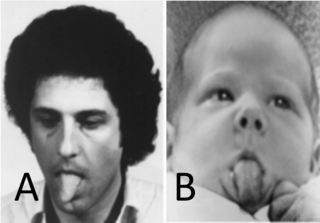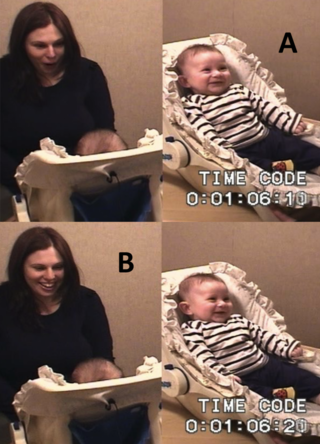Cognition
NonVerbal Precursors of Language: I
Intersubjective relations provide an emotional foundation of language.
Posted June 11, 2020

That language is a uniquely human form of communication is hardly news. Less obvious is the importance of two non-verbal precursors that are also uniquely human.
In this blog post, we describe the first such precursor: face-to-face intersubjective relations between an infant and her mother. The second precursor, joint attention, will be the topic of the next post.
A newborn human infant is the most helpless of all primates. At birth, the volume of an infant’s brain is approximately 25% of its adult volume. By comparison, it’s 50% in chimpanzees. Similarly, the skeletal nervous system of newborn infants is so poorly developed that they lack the coordination to crawl, let alone walk until they are 9 to 12 months old. As a result, human infants, unlike all other primates, have to be cradled.
As compensation, as it were, for an infant’s lack of mobility, cradling contributes significantly to the development of language. Because cradling brings the infant's eyes close to her mother’s, it allows them to develop a communicative bond in which they share gaze, vocalizations, and facial expression. Moreso than any other primate, human infants are extremely responsive to faces, in particular to another person’s eyes and mouth.

Responding to human faces and mutual gaze contribute to a dramatic example of intersubjectivity. Andrew Meltzoff, a developmental psychologist, showed that an infant can imitate an adult’s facial expression 42 minutes after birth. While the infant sucks on a pacifier, an adult protrudes his tongue (Image A). After a minute, the adult removes the pacifier. About two minutes later, the infant gradually succeeds in protruding her tongue (Image B).
A newborn infant’s ability to imitate is remarkable because the infant has never seen her own face. To imitate, she has to match information from two modalities: her perception of the adult’s face and proprioceptive feedback from the muscular activity of her own face. As Meltzoff commented, “The self can be felt, but cannot be seen. The other’s face can be seen but not felt. Yet self and others connect. The other can be understood as like me, at least in the sense that we can do the same acts (italics added)” (Meltzoff & Moore, 1998).
As impressive as imitation by a newborn infant is, it refers to individual events. Those events don’t do justice to the ongoing interactions that an infant and her mother establish early during infancy. To capture those interactions, developmental psychologists have focused on the dyad of infant and mother, and how their behavior is coordinated as they interact face-to-face.
Even though infants don’t produce phonemes (the basic unit of speech) until they are six months old, they can make other sounds such as positive vocalizations, whimpers, or angry protests. And even though they are unable to crawl or stand, they can smile, or frown, move their hands, turn their heads, and so on. Measurement of infant-mother coordination, however, can be problematic. Because it is often too rapid to experience in real-time, developmental psychologists record it on audio and/or videotape. That allows the mother’s and the infant’s behaviors, such as gaze, vocalizations, and facial affect, to be assessed by well-trained observers.
A pioneering study by Mary Bateson recorded the relation between the vocal responses of two-month-old infants and their mothers (Bateson, 1979). In response to the mother saying, “What you gonna say?,” “Huh?,” “Oh my!,” “You gonna be a good boy today?” and so on, the infant often responded by cooing, grunting, whimpering, and making other infant sounds. Bateson reported a strong correlation between the mother’s utterances and the infant’s vocal responses.
Because there was little temporal overlap between those utterances, Bateson referred to them as “proto-conversations.” That interpretation seems justified because the infant and the mother alternated their utterances, in a turn-taking pattern, just as adults do in real conversations.

To provide a dynamic view of reciprocal displays of mother-infant interactions of effect, Colwyn Trevarthen, Dan Stern, Berry Brazelton, and other developmental psychologists introduced the method of “microanalysis” in the 1980s. While a mother and her three- to four-month-old infant engage in face-to-face play, they are videotaped by separate cameras. The videotapes are time-synched and displayed on a split-screen and later assessed moment-by-moment for expressions of gaze, vocalization, and affect.

Consider, for example, the two synched frames of mother and infant shown on the left. They illustrate a study in which Beatrice Beebe measured gaze, facial expression, and vocal affect while a mother and her infant gazed at each other (and sometimes away) during a three-minute session of unstructured play (Beebe, et al., 2016).
The numerical entry beneath the infant’s images on the right side of the upper frame specifies the time (minutes, seconds, and 30ths of a second) of the interaction. In A, the infant smiles at her mother. A third of a second later, (in B, lower left), the mother smiles back. Using microanalysis, Beebe showed that each person's patterns of looking and degree of positive vocal and facial affect, including smiling, were highly correlated with those of the partner throughout the session. Moreover, each person's behavior influenced that of the other.

Beebe and her colleagues also used microanalysis in a study that recorded the onset and offset of vocalizations of three- to four-month-old infants and their mothers, in units as short as 250 milliseconds (Jaffe, Beebe, et al., 2001). Turn-taking was measured by comparing the duration of the infants’ and mothers’ switching pauses: that is, the time that elapsed between the offset of one partner’s vocalization and the onset of the other’s.
The duration of switching pauses ranged from 0.1 to 1 second. As was the case with gaze, and facial and vocal affect, there was a high correlation between the duration of the mother’s and the infant’s switching pauses. Each person paused for a similar duration before the partner took a turn, each adjusting the duration of the pause to match that of the other. This finding showed that turn-taking is regulated by matching switching pauses.
Those exchanges can be likened to dance between partners of differing abilities who are trying to keep in step by maintaining a mutual rhythmic pattern. Although neither partner dances precisely to a particular beat, they can each vary the duration of their steps. That helps them to synchronize their dancing.
While observing a mother playing with her infant, it is natural to be charmed by their loving exchange of gazes and smiles. But the next time you observe such play, keep in mind that developmental psychologists have uncovered its remarkable coordination. As we shall see in the next blog post, that uniquely human emotional coordination provides an important foundation for language.
This post was co-authored by Beatrice Beebe, Clinical Professor of Medical Psychology at the College of Physicians & Surgeon, Columbia University.
References
Bateson, M. C. (1979). The epigenesis of conversational interaction: A personal account of research development. In M. Bullowa (Ed.), Before speech: The beginning of interpersonal communication (pp. 63-78). Cambridge, UK: Cambridge University Press.
Beebe, B., Messinger, D., Bahrick, L. E., Margolis, A., Buck, K., & Chen, H. (2016). A Systems View of Mother-Infant Face-to-Face Communication. Developmental Psychology, 32(4), 556-571.
Jaffe, J., Beebe, B., Feldstein, S., Crown, C., & Jasnow, M. (Eds.). (2001). Rhythms of dialogue in infancy (Vol. 66). Boston: Blackwell Publishers.
Meltzoff, A. N., & Moore, K. M. (1998). Infant intersubjectivity: Broadening the dialogue to include imitation, identity and intention. In S. Bråten (ed.), Intersubjective communication and emotion in early ontogeny (2006). Cambridge: Cambridge University Press.




